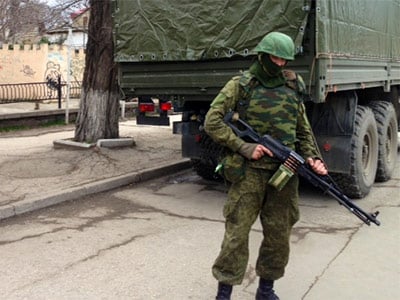A Ten-Point Plan for Ukraine
A package deal for the United States and Russia.
 President Obama’s inbox is doubtless packed with proposals for stopping the standoff between Ukraine and Russia.
President Obama’s inbox is doubtless packed with proposals for stopping the standoff between Ukraine and Russia.
Well, here’s another plan. But before I offer the details, some background to provide context:
Ukrainian president Viktor Yanukovych’s fall (and subsequent flight to Russia) on February 22 led to the formation of a government run by the opposition, about which Moscow had harbored deep suspicions.
What the West hailed as a democratic triumph, President Vladimir Putin denounced as an “extra-constitutional coup” against an elected leader and as another example of a Western (particularly American) plot to undermine Russia in its historic spheres of influence.
Putin’s recourse to legality is rich. Revolutions by their nature bypass constitutions. And if Yanukovych’s ouster is illegal, the referendum that Crimea’s new pro-Russian leadership—which itself seized power from the local authorities—plans for March 16 to determine whether the province should join the Russian Federation is no less so.
Ukraine’s constitution (Chapter III, Articles 72 and 73) stipulates that referendums must be: i) called solely by the president or the parliament (Verkhovna Rada); ii) held pursuant to a petition that garners 3 million signatures with a minimum of 100,000 per province from at least two-thirds of the country’s provinces; iii) national in scope on territorial questions. The proposed Crimean referendum meets none of these requirements.
But this crisis is not about constitutional law. It’s about power, prestige, security, and fear—the stuff that has pitted polities against one another for millennia.
With the Sochi Winter Olympics behind him, Putin turned immediately to Ukraine. And he took off the gloves, launching a military takeover of the Crimea that cashed in on three advantages. First, thousands of Russian troops were already stationed there—Russia’s Black Sea Fleet is based in Sevastopol under a lease that runs to 2040—and more were dispatched, permitting a rapid occupation of key government buildings and military installations. Second, ethnic Russians constitute the majority (58 percent) of Crimea’s population and offered a hospitable political environment. Third, Crimea is on Russia’s doorstep, and that put the West at a strategic disadvantage.
This is where we are. What is to be done?
Both Mr. Putin and Mr. Obama require a solution that allows them to claim victory. Mr. Putin is determined to emerge from this mess with his tough-guy image burnished—as much for internal reasons as external ones. Mr. Obama has been flayed in right-wing circles for, in effect, having encouraged this crisis and needs to demonstrate that he isn’t the wimp his critics claim he is.
Here’s the ten-point plan—a package deal—designed to preserve both presidents’ dignity and to calm the crisis:
● Ukraine’s interim government is broadened to include members of Mr. Yanukovych’s Party of the Regions, though not Yanukovych himself (his days are over), and leaders from the Crimea trusted by Russia. The anti-Yanukovych opposition retains a majority of cabinet posts and controls the military, the police, and the intelligence services.
● Mr. Putin orders Russian troops in Crimea back to their barracks and recalls all security personnel and equipment deployed there after February 22.
● Russia reaffirms its commitment to Ukraine’s territorial integrity—a provision contained in the December 1994 Budapest Memorandums on Security Assurances it signed together with Ukraine, the United States and Britain.
● Ukraine declares a policy of neutrality and nonparticipation in military alliances.
● Notwithstanding Ukraine’s neutrality, Russia’s basing rights in Crimea are guaranteed till 2040. As a reciprocal gesture, Russia assures Ukraine uninterrupted gas supplies at the discount rate it offered Yanukovych in February.
● The EU, Russia, the United States and Ukraine create a contingent of peacekeepers to prevent violence in Crimea and the Russophone Donbas region. Each party provides one-fourth of the total and agrees to intermixed deployments and patrols.
● The Ukrainian leadership commences negotiations—even before the presidential election scheduled for May 25—with Crimean leaders to increase the local leeway of the peninsula, which is already an “autonomous republic” as per Chapter X of the constitution.
● Ukraine and Russia undertake to establish a demilitarized zone (applying to ground and air forces) along Ukraine’s eastern border to forestall Crimea-like conflagrations in the Donbas, something that would make this crisis far more dangerous. International monitors verify compliance.
● Kyiv pledges to keep its forces in eastern Ukraine within their bases, and Mr. Putin calls on pro-Russian groups in the Donbas to eschew violence and other provocations.
● To prevent spin, theatrics, and bullhorn diplomacy, the parties—Russia, Ukraine, the US and the EU—agree to negotiate under a media blackout and to ban public statements. (NATO secretary general Anders Fogh Rasmussen is sent on a silent retreat.)
Mr. Obama’s critics will protest that this plan concedes too much; Mr. Putin’s, that it doesn’t offer enough. But it gives both presidents a framework within which to conduct the detailed negotiations needed to tamp down a perilous crisis.
Rajan Menon is the Anne and Bernard Spitzer Professor of Political Science at the Colin Powell School, City College of New York/City University of New York, and Non-Resident Senior Fellow at the Atlantic Council.
